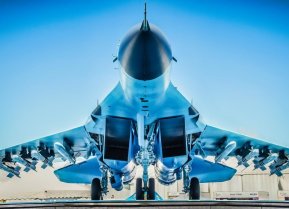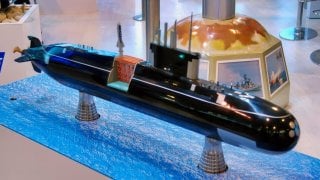Lada-Class: Russia's Failed Diesel Submarine (No One Will Buy It)
Project 677 Lada-class submarines are often referred to as the fourth generation of diesel-electric submarines, developed by a Russian Rubin design bureau
In July, the Project 677 Lada-class (NATO reporting name "St. Petersburg") diesel-electric submarine Kronstadt completed a deep-sea immersion as part of its continuing sea trials, within the maritime ranges of the Baltic Fleet.
The submarine crew verified the functioning of all onboard mechanisms and systems, practicing control algorithms at great depths and under various surfacing conditions, Naval Recognition reported at the time.
During the sea trials, the Kronstadt reached a depth of 180 meters at one of the Baltic Fleet's ranges, while the dive was facilitated by fleet forces and resources, including the rescue ship SS-750. The results of the submarine's dive were reported to the Commander-in-Chief of the Russian Navy, Nikolay Yevmenov.
Lada-Class: The Slow Boat
Construction of the Kronstadt – the first serial submarine of Project 677, following the Sankt Peterburg – began in July 2005 but was suspended by the Ministry of Defense of the Russian Federation in 2009 until 2013.
The submarine was only launched in 2018, and it took until the end of 2021 for the boat to commence its sea trials, which were prolonged due to ongoing modernization.
The submarine had been scheduled to join the Russian fleet this year, yet, there have been no reports that has occurred. When the Kronstadt finally enters service, it is expected to serve in the Northern Fleet, where the lead submarine of the project, Sankt Peterburg, is already in service. That decision had been announced at a conference call meeting at the Ministry of Defense in early March this year.
It was during that call that Russian Minister of Defense Sergey Shoigu confirmed that the submarine would carry Kalibr cruise missiles.
"The first issue on the agenda is the construction of the large submarine Kronshtadt that will enter service with the Northern Fleet. The ship is set to feature Kalibr cruise missiles, the latest radar, sonar and navigational systems. This will considerably boost its combat efficiency," Shoigu was quoted as saying by state media outlet Tass.
Lada-Class Key Details
Project 677 Lada-class submarines are often referred to as the fourth generation of diesel-electric submarines, developed by a Russian Rubin design bureau. It is essentially an improved version of the Kilo-class and was designed to be fitted with an air-independent propulsion (AIP) along with new combat systems. The AIP system was meant to increase submerged endurance to 45 days, while its submerged cruising range was 500 nautical miles (900 km) at three knots.
The boats have a surface displacement of about 1,750 tonnes and can develop an underwater speed of up to 21 knots, and an endurance of 45 days. The Lada-class subs are armed with Kalibr cruise missile systems along with six 533 mm torpedo tubes for a mix of 18 torpedoes or tube-launched missiles. These may include the Alfa (NATO reporting name SS-N-27 or Sizzler) multi-role cruise missiles, or Oniks (SS-N-26) anti-ship cruise missiles.
The boats reportedly have a crew of 35 including officers and sailors.
The boats were initially developed and designed to protect naval bases, coastal installations, and sea lanes from hostile submarines and ships, while these boats can also perform patrol and surveillance tasks, including anti-submarine warfare (ASW) and anti-surface warfare (AsuW) operations.
Problem-Plagued Platform
Sankt Petersburg (B-585), the lead submarine of the project, was launched in late 2004 and commissioned in 2010. However, she was not accepted by the Russian Navy as it was discovered there were issues with the boat's propulsion and that its sonar systems did not meet Russian specifications.
Construction on the remaining boats of Project 677 was thus frozen.
The issues with the lead submarine were eventually addressed, but only after several years of serving as a "test platform," she was formally accepted into service with the Russian Navy last year. Sankt Petersburg officially joined the Northern Fleet in September 2021.
Russia was unable to resolve the issues with the fuel cells for the AIP, and as a result the second boat of the class, the Kronstadt, was fitted with an ordinary diesel-electric propulsion system without the AIP system.
Currently, the Admiralty Shipyard is also building one more Lada-class submarine, the future Velikiye Luki, while the first steel was cut for the next two boats with a third also on order. Originally a full dozen of the diesel-electric boats were ordered, but given the issues with the program, it is unclear if that order has been pulled.
Export Model – With No Buyers
Russia had further developed an export variant of the Lada-class: the Project 1650 Amur-class (named for the Amur River), which was designed for markets including India and China, while Morocco has also been offered one. The export submarine could be offered in various configurations with a displacement of 550 to 1,850 tonnes and be equipped with a variety of weapon systems.
To date, there have been no buyers for the submarines, and given the problems with the boats as well as the sanctions placed on Russia, following its unprovoked invasion of Ukraine, the Amur-class could be dead in the water.
Author Experience and Expertise
Peter Suciu is a Michigan-based writer. He has contributed to more than four dozen magazines, newspapers, and websites with over 3,200 published pieces over a twenty-year career in journalism. He regularly writes about military hardware, firearms history, cybersecurity, politics, and international affairs. Peter is also a Contributing Writer for Forbes and Clearance Jobs. You can follow him on Twitter: @PeterSuciu.
Image Credit: Creative Commons.


